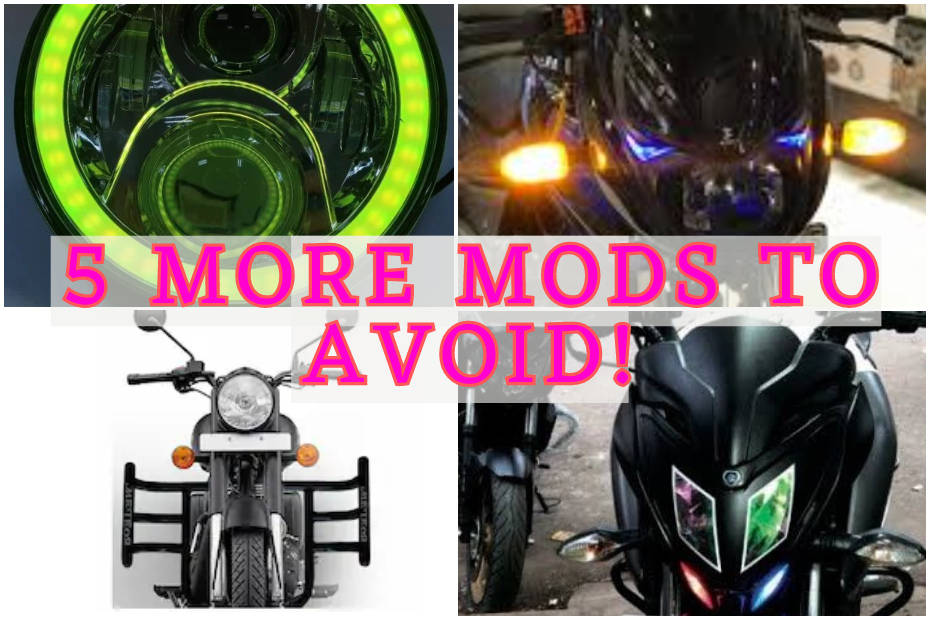Weird, Wacky, And Dangerous: 5 More Two Wheeler Modifications To Avoid
Published On Mar 24, 2024 11:00 AM By Sudipto Chaudhury
- 2983 Views
Some more add-ons people install that, you guessed it, put themselves AND others in danger!

Riding a two-wheeler in a developing country like India is mostly a necessity. Granted, enthusiasts like us prefer cutting through traffic on a fast and fun two-wheeled machine. The vast majority, however, look for vehicles to just get them from A to B. But there’s a third kind too: those looking to make a statement on their two-wheelers, though in quirky (and mostly illegal) ways, which we have earlier detailed.
And from all the responses we got from our previous article, we realised there are some more “modifications” people do on their two-wheelers. So here are 5 more unsuitable (read: ‘dangerous’ or ‘illegal’) add-ons to avoid:
Aftermarket crash guards

“But crash guards are useful additions,” you’ll say, and rightly so. But not these. For perspective, factory-fitted crash guards are designed to be just wide enough to protect the engine (and the rider’s lower legs) from large debris. Besides, they should be tensile enough to deform in case of a crash, so as not to transfer the impact onto – and hence damage – the bike’s chassis.
The “crash guards” we’re talking about here, however, are usually extra-wide (sometimes even more than the handlebar) and extra-thick (enough to double up as fence posts). Some are even designed as holders for weapons! As a result, these “fancy crash guards” are not only heavy enough to affect the bike’s handling, but their width can even hamper the front suspension’s travel (by hitting the front tyre/mudguard).

A better way to protect both yourself and your bike, then, is to practice riding defensively (and always at a comfortable pace), and wear adequate riding gear.
Tail Light/indicator mods

While a motorcycle’s tail light tells fellow road users one’s position on the road (and intensifies as we brake), the indicators signal a turn. Some bikes nowadays even offer 'hazard light' functionality, useful in the off chance you're stuck on the roadside after dark.
And yet, some people treat these vital instruments as a style choice, with aftermarket electrical relays that randomly flash the tail light and indicators, for “better visibility.” Best-case scenario: It distracts fellow road users. Worst-case scenario: An accident, as the one behind you could not realise that you were indeed braking/turning.
Better to wear brightly coloured riding gear with reflective panels, and if that’s not enough, attach reflective tape onto your two-wheeler’s body.
Multi-colour headlights

Headlights, across vehicles, usually project one of two colours: bright yellow from halogen lights, and white from LED. So what do those small green/blue/multicolour flashes in your rear view mirror mean? They mean that the two-wheeler rider behind you is ready to put their life in danger!
It goes without saying how important headlights are. So why fiddle with this legally mandated instrument? Yes, law enforcement and emergency vehicles use multi-coloured lights, but those are mounted on their roofs, and usually accompanied by a siren. So replacing a two-wheeler’s headlight with “disco” lights isn’t just dangerous, it’s illegal too.
Smoked headlight/taillight/indicator

Rounding off the lighting trifecta are people so interested in superhero movies that they cover their headlights with their favourite characters' likeness. But that’s not all: some others are under the misconception that ‘stealth’ (a quality seen in video games) makes sense in real life. Why else would someone cover up the lights on their vehicle?

Granted, some two-wheelers like the Hero Xtreme 160R get a smoked taillight by default. However, not only does the bike’s relatively bright LED easily offset the plastic cladding’s smoked effect, but the overall treatment is infinitely better (and of course safer) than a cheap tinted wrap.
And if you’re still not convinced, please refer once again to point number 2 in this list.
Removing mirrors

Racing motorcycles do not have rear view mirrors, to save some weight as well as gain an aerodynamic advantage, both of which can help win a race. However, racing motorcycles never go on the public roads, so these minor aerodynamic and weight-saving advantages make no difference in everyday traffic. Besides, riding without mirrors means one has no idea of what’s going on behind them, which may lead to dangerous consequences.

And if that wasn’t enough, a subset of the ‘mirror remover’ crowd attaches small idols to the mirror sockets. These (usually cheaply made) knick-knacks can break off and cause further injury in case of a crash.
And finally, as with the lights, it’s illegal to remove or alter the mirrors on your vehicle. However, there is a workaround here, for you to be (temporarily) free of your mirrors: Enrol in a racetrack training programme!
This concludes part 2 of the list of two-wheeler violations to avoid. Is there anything we’re still missing out on? Tell us in the comments below!
